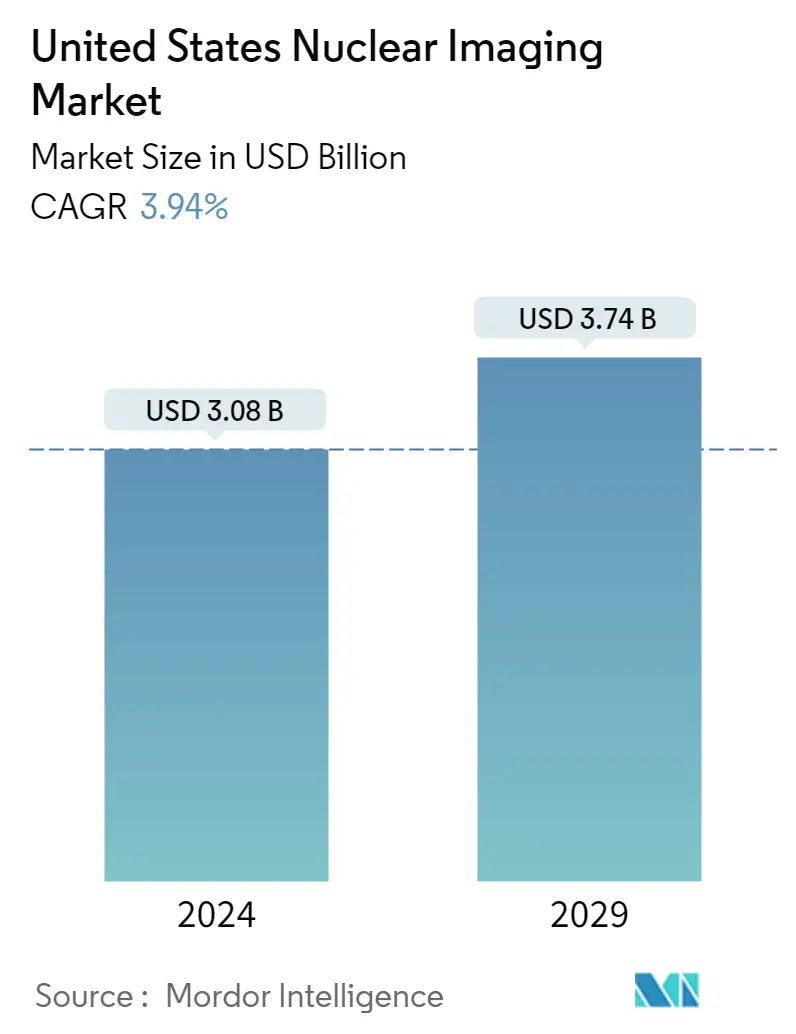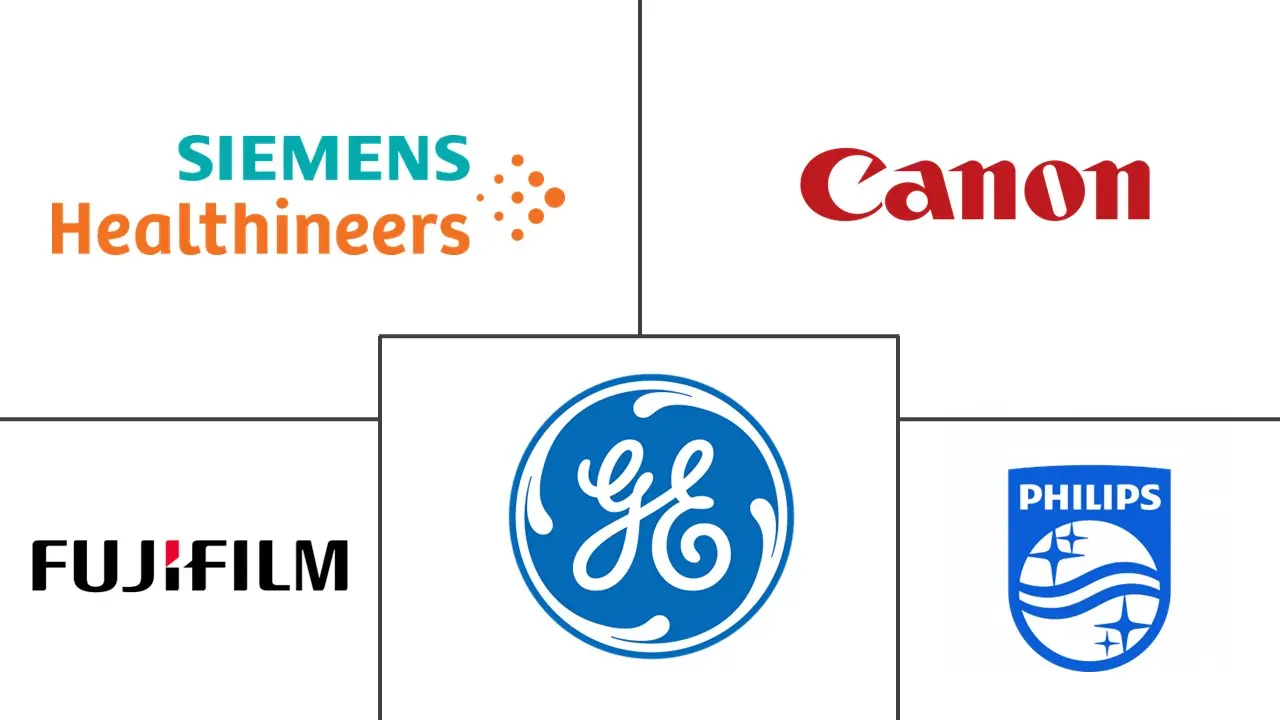Market Size of United States Nuclear Imaging Industry

| Study Period | 2019 - 2029 |
| Base Year For Estimation | 2023 |
| Market Size (2024) | USD 3.08 Billion |
| Market Size (2029) | USD 3.74 Billion |
| CAGR (2024 - 2029) | 3.94 % |
| Market Concentration | Medium |
Major Players
*Disclaimer: Major Players sorted in no particular order |
US Nuclear Imaging Market Analysis
The United States Nuclear Imaging Market size is estimated at USD 3.08 billion in 2024, and is expected to reach USD 3.74 billion by 2029, growing at a CAGR of 3.94% during the forecast period (2024-2029).
The pandemic had an adverse effect on the market growth in the United States. Due to COVID-19 in the country, most radioiodine treatments were delayed, and all the conventional nuclear imaging studies FDG PET scans were canceled. The number of nuclear studies, nuclear cardiac imaging, and oncology PET/CT decreased in March and April 2020 as a result of the rise in COVID-19 cases and deaths, according to the article "The Impact of COVID-19 on Nuclear Medicine Operations Including Cardiovascular Manifestations in the USA" published in ScienceDirect Journal in June 2021. (CDC). These studies and procedures increased from June 2020 to February 2021 as the COVID-19 instances decreased throughout the country. As the accuracy of COVID-19 testing was improved, more successful vaccination drives against COVID-19 were made, and as a result, there was a decline in new cases in many regions across the country, Society of Nuclear Medicine and Molecular Imaging (SNMMI) issued a statement in September 2020 and March 2021 notifying resume ventilation studies on a case-by-case basis electively diagnosing lung disease, including vascular and airway disease. The nuclear imaging market has been influenced by COVID-19 because there have been delays in clinical research, cancellations of various surgeries and imaging procedures, an increase in teleradiology, and a number of staff-related restrictions. Thus, the market is expected to grow in the future.
In the United States, the burden of chronic diseases is increasing, and medical imaging technologies are essential to the precise detection of chronic diseases like cancer. Another aspect of market expansion is the quantity of brain-related injuries. Cancer incidence is anticipated to propel market expansion. For instance, in 2020, around 2,281,658 new cases of cancer were reported in the United States, according to GLOBOCAN 2020. According to the National Brain Tumor Society, there will be around 85,000 new cases of brain tumors in the United States in 2020, with 700,000 Americans already living with one. The growing prevalence of chronic diseases and the aging population in the United States are providing market participants with enormous potential, which is fueling the industry's expansion. The big players are engaged in a variety of strategic activities. These include product launches, collaborations, partnerships, mergers, and acquisitions. For instance, in June 2021, Persona RF PREMIUM was introduced in the US by FUJIFILM Medical Systems U.S.A., Inc. For hospitals and healthcare facilities of all sizes, the Persona RF PREMIUM is a cutting-edge radiography and fluoroscopy system that offers real-time imaging for the skeletal, digestive, urinary, respiratory, and reproductive systems as well as individual organs like the heart, lung, and kidneys. Similarly, in June 2021, The FDA has granted Canon Medical's digital PET/CT system in the United States of America clearance for its AI-based image reconstruction technology.
However, the lack of proper reimbursement and stringent regulatory approval procedures, and the high cost of equipment, are expected to impede the market growth in the United States.
US Nuclear Imaging Industry Segmentation
As per the scope of the report, nuclear medicine imaging procedures are non-invasive, with the exception of intravenous injections, and are usually painless medical tests that help physicians diagnose and evaluate medical conditions. These imaging scans use radioactive materials called radiopharmaceuticals or radiotracers. These radiopharmaceuticals are used in diagnosis and therapeutics. They are small substances that contain a radioactive substance that is used in the treatment of cancer, and cardiac and neurological disorders. The United States Nuclear Imaging Market is segmented by Product (Equipment, and Diagnostic Radioisotope (SPECT Radioisotopes, and PET Radioisotopes), Application (SPECT Application (Cardiology, Neurology, Thyroid, and Other SPECT Applications), and PET Application (Oncology, Cardiology, Neurology, and Other PET Applications). The report offers the value (in USD million) for the above segments.
| By Product | ||||
| Equipment | ||||
|
| By Application | ||||||
| ||||||
|
United States Nuclear Imaging Market Size Summary
The United States nuclear imaging market is poised for growth, driven by the increasing prevalence of chronic diseases and the aging population. Despite the initial setbacks caused by the COVID-19 pandemic, which led to delays and cancellations of nuclear imaging procedures, the market is expected to recover and expand. The demand for precise medical imaging technologies is crucial for the detection of conditions such as cancer and brain-related injuries, which are on the rise. This demand is further bolstered by advancements in technology and strategic initiatives by key players in the industry, including product launches and collaborations. Companies like FUJIFILM Medical Systems and Canon Medical are at the forefront, introducing innovative systems and obtaining regulatory approvals to enhance imaging capabilities.
The market landscape is moderately competitive, with major players such as Canon Inc., GE Healthcare, Siemens Healthineers AG, Fujifilm Holdings Corporation, and Koninklijke Philips NV leading the charge. These companies are actively engaged in expanding their product offerings and integrating advanced technologies like artificial intelligence to improve diagnostic accuracy. However, challenges such as high equipment costs, stringent regulatory approvals, and reimbursement issues may impede growth. Despite these challenges, the market is supported by a robust infrastructure of PET/CT facilities and a growing number of nuclear medical operations performed annually. Initiatives like the Mars Shot Fund by the Society of Nuclear Medicine and Molecular Imaging aim to further bolster research and development in the field, highlighting the sector's potential for continued expansion.
United States Nuclear Imaging Market Size - Table of Contents
-
1. MARKET DYNAMICS
-
1.1 Market Overview
-
1.2 Market Drivers
-
1.2.1 Increasing Prevalence of Chronic Diseases
-
1.2.2 Rising Geriatric Population
-
1.2.3 Increasing Technological Advancements
-
-
1.3 Market Restraints
-
1.3.1 Lack Of Proper Reimbursement And Stringent Regulatory Approval Procedures
-
1.3.2 High Cost of Equipment
-
-
1.4 Porter's Five Force Analysis
-
1.4.1 Threat of New Entrants
-
1.4.2 Bargaining Power of Buyers/Consumers
-
1.4.3 Bargaining Power of Suppliers
-
1.4.4 Threat of Substitute Products
-
1.4.5 Intensity of Competitive Rivalry
-
-
-
2. MARKET SEGMENTATION (Market Size by Value - USD million)
-
2.1 By Product
-
2.1.1 Equipment
-
2.1.2 Diagnostic Radioisotope
-
2.1.2.1 SPECT Radioisotopes
-
2.1.2.2 PET Radioisotopes
-
-
-
2.2 By Application
-
2.2.1 SPECT Application
-
2.2.1.1 Cardiology
-
2.2.1.2 Neurology
-
2.2.1.3 Thyroid
-
2.2.1.4 Other SPECT Applications
-
-
2.2.2 PET Application
-
2.2.2.1 Oncology
-
2.2.2.2 Cardiology
-
2.2.2.3 Neurology
-
2.2.2.4 Other PET Applications
-
-
-
United States Nuclear Imaging Market Size FAQs
How big is the United States Nuclear Imaging Market?
The United States Nuclear Imaging Market size is expected to reach USD 3.08 billion in 2024 and grow at a CAGR of 3.94% to reach USD 3.74 billion by 2029.
What is the current United States Nuclear Imaging Market size?
In 2024, the United States Nuclear Imaging Market size is expected to reach USD 3.08 billion.

